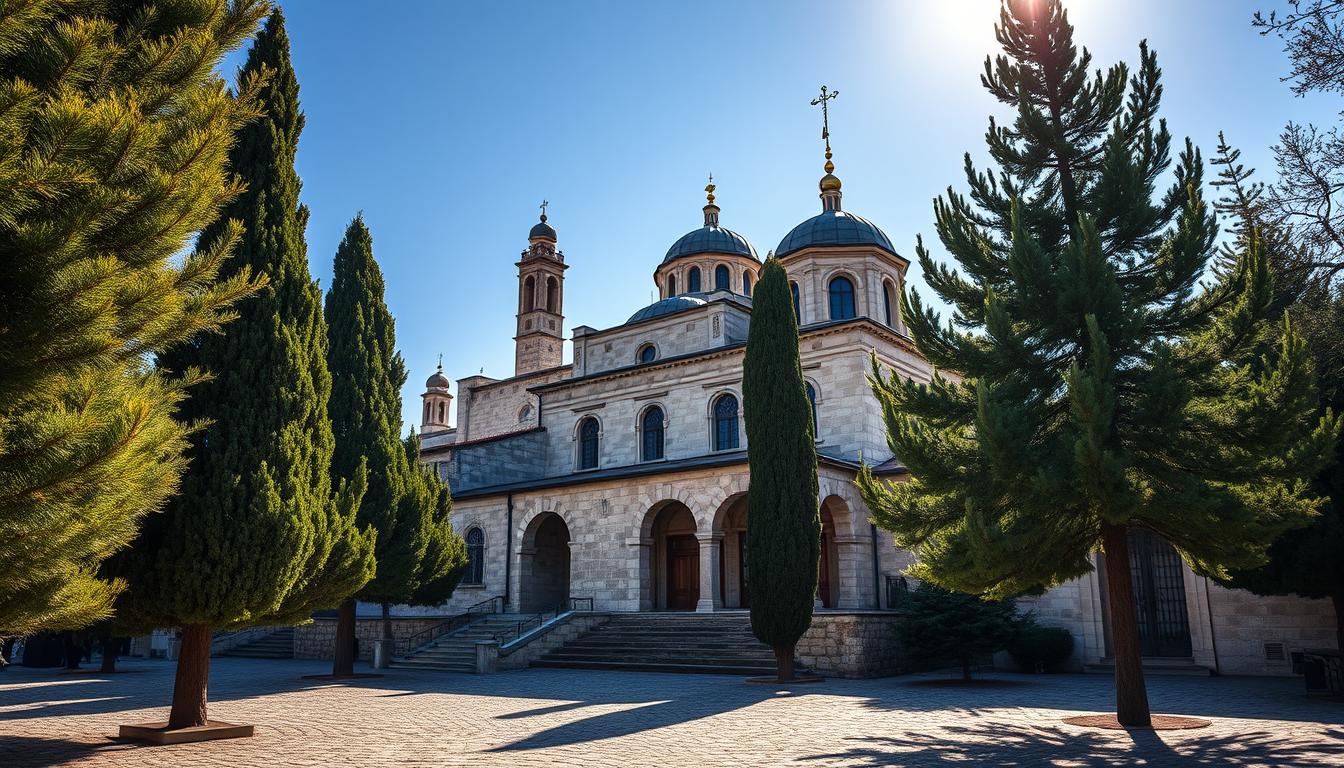Stepping onto the holy mountain of Mount Athos feels like entering a world untouched by time. This sacred place, home to ancient monasteries and devout monks, offers a unique spiritual experience. However, to preserve its sanctity, certain guidelines must be followed. These rules ensure that every pilgrim respects the traditions and values of this revered site.
Visitors must dress modestly, avoiding shorts or sleeveless shirts, and adhere to strict behavioral standards. Photography and phone use are limited to maintain the peaceful atmosphere. Each visitor is allowed a maximum stay of four days, and reservations must be made in advance through the Pilgrim’s Bureau1. Confirmation typically arrives within two weeks after submitting a passport copy1.
Understanding and respecting these guidelines is essential. They not only honor the spiritual heritage of Mount Athos but also enhance your journey. By following these rules, you contribute to preserving this sacred place for future generations.
Key Takeaways
- Dress modestly to respect the traditions of the holy mountain.
- Limit the use of technology to maintain the peaceful environment.
- Reservations must be made in advance through the Pilgrim’s Bureau.
- Visitors are allowed a maximum stay of four days.
- Confirmation of reservations typically takes two weeks.
- Understanding the rules enhances your spiritual journey.
- Respecting guidelines preserves the sanctity of Mount Athos.
Introduction to the Holy Mountain Experience
Mount Athos stands as a beacon of spiritual devotion, offering a journey unlike any other. This sacred place, with its 20 monasteries and dependencies, has been a center of Orthodox tradition for over a millennium2. Its serene environment and rich history make it a unique destination for those seeking a deeper connection to their faith.
The Spiritual Significance of Mount Athos
For centuries, Mount Athos has been a sanctuary for monks and pilgrims alike. Its marble peak, rising 6,670 feet, symbolizes the heights of spiritual aspiration2. The monasteries here are not just buildings; they are living testimonies to a life of prayer and contemplation. This holy mountain is a place where the divine feels tangible, and every step you take is a step closer to inner peace.
Understanding Who Can Visit and the Avaton Rule
Access to Mount Athos is governed by the Avaton rule, a tradition dating back centuries. Only men and young males accompanied by their fathers are permitted to enter2. This rule ensures that the mountain remains a place of spiritual focus, free from distractions. It’s a reminder that this journey is not just about seeing a place but about embracing a way of life.
As a pilgrim, you are not just a visitor but a participant in a sacred tradition. Respect and devotion are at the heart of this experience. The connection between old-world traditions and modern-day procedures ensures that the sanctity of Mount Athos is preserved for generations to come.
Rules for Visiting Mount Athos

To truly experience Mount Athos, one must embrace its timeless practices. This sacred place is not just a destination but a journey into a world of spiritual discipline and reverence. Adhering to its customs ensures that every pilgrim respects the sanctity of this holy site.
Adhering to the Modest Dress Code
Dressing modestly is a cornerstone of your visit. Men are required to wear long-sleeved shirts, long pants, and closed shoes. Sandals are only acceptable in summer, provided they are worn with socks3. This attire reflects the humility and respect expected of every visitor.
Sportswear or printed shirts are discouraged, as they detract from the reserved atmosphere. Specific monasteries may enforce stricter guidelines, especially during services and meals. By dressing appropriately, you honor the traditions of this sacred place.
Observing Restrictions on Technology and Noise
Maintaining silence and limiting technology use are essential. Mobile phones must be turned off during liturgies and in the refectory4. This ensures that the focus remains on prayer and reflection, preserving the peaceful environment.
Audio and video recording are also prohibited inside sacred sites. These restrictions are not just rules but invitations to disconnect from the outside world and immerse yourself in the spiritual life of Mount Athos. By embracing these practices, you contribute to the transformative experience of this holy journey.
Obtaining Permits and Making Advance Reservations
Planning your journey to this sacred destination requires careful preparation and respect for its traditions. To enter, you’ll need a Diamonitirion, a special permit issued by the Pilgrims’ Bureau in Thessaloniki5. This document grants you access to the monasteries and sketes, ensuring your visit aligns with the spiritual rhythm of the area.
Applying for General and Private Permits
There are two types of permits: general and private. The general permit allows a four-day stay and is ideal for first-time pilgrims. Private permits require an invitation from a specific monastery and are often used for longer stays or special services5. Both require advance scheduling, especially during the busy summer months.
Foreign visitors must contact the Pilgrims’ Bureau via phone, fax, or email. You’ll need to appear in person with your passport to finalize the process6. This ensures your reservation is confirmed and your entry is seamless.
Scheduling Your Stay at Monasteries and Sketes
Once your permit is secured, the next step is arranging your stay. Most monasteries and sketes require advance notice, particularly if you plan to stay overnight5. This allows them to prepare accommodations and include you in their daily services.
By planning ahead, you ensure your visit is in harmony with the monastic schedule. This not only enhances your experience but also shows respect for the spiritual life of the community. A well-organized trip allows you to fully immerse yourself in the sacred atmosphere of this revered place.
Navigating Transportation and Travel Logistics

Reaching this sacred destination requires thoughtful planning and an understanding of the available transportation options. Whether you choose to travel by boat, bus, or on foot, each method offers a unique way to experience the spiritual journey to this revered place.
Exploring Boat, Bus, and Walking Options
Boat travel is the most common way to access the area. Ferries like Mount Athos Lines and Microathos operate from Ouranoupolis and Ierissos, with specific departure times that vary by season7. These services connect you to the monasteries and sketes, making it a convenient choice for many pilgrims.
For those preferring land travel, bus services like KTEL CHALKIDIKIS are available from Ouranoupolis. These buses provide a reliable way to reach the entry point, but schedules should be checked in advance to avoid delays7.
Walking is another option for the adventurous. The mountainous terrain offers breathtaking views, but proper gear, water, and maps are essential. This method allows you to fully immerse yourself in the natural beauty of the area.
Planning Travel Itineraries and Checking Timetables
Planning your trip in advance is crucial. Boat and bus schedules change seasonally, so verifying the latest timetables ensures a smooth journey7. This also helps you align your visit with the daily services at the monasteries.
Adhering to the timing schedule is vital for a seamless entry. Whether you’re arriving by boat or bus, being punctual shows respect for the life and traditions of this sacred place.
By choosing the right transportation method and planning ahead, you can fully appreciate the spiritual journey to this unique destination. Each option offers a different perspective, enriching your experience as a visitor.
Essential Etiquette and Conduct on the Holy Mountain
Respect and humility are the cornerstones of your experience here. The monastic community thrives on traditions that have been preserved for centuries. By embracing these customs, you honor the spiritual essence of this sacred place.
Proper Behavior During Liturgies and Meals
During liturgies, stand quietly and follow the lead of the monks. Silence is essential, allowing everyone to focus on prayer and reflection. Avoid distractions like phones or cameras, as they disrupt the serene atmosphere.
Meals in the monastery are a communal experience. Stand before your seat until the abbot gives a blessing. Eat in silence, showing gratitude for the food and the opportunity to share in this tradition.
Respecting Monastic Traditions and Sacred Sites
When visiting churches or sketes, act with reverence. Avoid touching icons or sacred objects unless invited. Photography and recording are strictly prohibited in these areas, preserving their sanctity.
Interact with monks and fellow pilgrims with humility. A polite demeanor and respectful attitude go a long way in fostering harmony. Remember, your conduct reflects your commitment to this spiritual journey.
Misconduct, such as breaking silence or ignoring guidelines, can lead to the withdrawal of your permit. By adhering to these practices, you contribute to the preservation of this holy mountain and its way of life.
For more detailed guidelines on planning your visit, check out this resource.
Conclusion
Your journey to this sacred destination is more than a trip—it’s a spiritual transformation. To ensure a respectful and fulfilling experience, proper preparation is essential. Start by securing your permit through the Pilgrims’ Bureau, as this document is your gateway to the monasteries and sketes8. Plan your reservation in advance, especially during peak seasons, to guarantee accommodations and participation in daily services.
Dress modestly and adhere to the guidelines, as this reflects your respect for the monastic traditions. Limit the use of technology, particularly during liturgies and meals, to maintain the serene atmosphere. Transportation options like boat and bus are available, but check the schedule to align with your itinerary8.
By following these steps, you honor the sanctity of this revered place. Your visit becomes not just a journey but a profound connection to a centuries-old way of life. For more insights, explore the pilgrims-progress story, which highlights the transformative power of this experience.
FAQ
What is the spiritual significance of Mount Athos?
Who is allowed to visit the Holy Mountain?
What should I wear during my visit?
Can I use my phone or camera on the Holy Mountain?
How do I obtain a permit to visit Mount Athos?
How do I schedule my stay at monasteries or sketes?
What transportation options are available on the Holy Mountain?
How should I behave during liturgies and meals?
What is the best time to visit Mount Athos?
Can I stay overnight on the Holy Mountain?
Source Links
- Pilgrim Information – Ouranoupoli.com
- Mount Athos | Greece, Map, History, Population, & Facts | Britannica
- How to Visit Mount Athos
- Holy Community of Mount Athos announces new measures for pilgrim access | Orthodox Times (en)
- The Complete Halkidiki Travel Guide: Your Passport to Greek Bliss – Travelodeal UK
- Thessaloniki Airport to Halkidiki: Your Ultimate Transportation Guide
- Rules for transporting cars by ferry in Greece – Nikana.gr
- The Life of Athos Monks | Athos.Guide

















